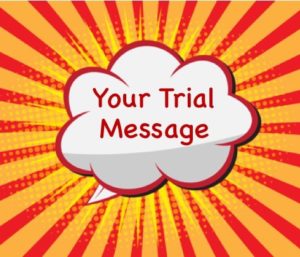By Dr. Ken Broda Bahm:

In popular culture, and to some extent in the preparation of trial lawyers, the ultimate focus is the trial. We think of that as the pinnacle moment for advocacy: in the courtroom, looking into the eyes of the judge or the jurors. Increasingly, however, that isn’t the reality. According to recent estimates, civil filings end in trial in fewer than one percent of the cases, a rate that applies to both jury and bench trials. That means that the wonderful theme you developed, along with all the other parts of your trial message, are quite likely to never see the inside of a courtroom. Does that mean that litigators facing hard limits on time, focus, and money are better advised to hold off on crafting their trial message, waiting on the very unlikely event that the case makes it all the way to trial? I’d say emphatically “No.”
Your trial message, even in the absence of the trial itself, is a critical touchstone in how your case, including its potential appeal to a future fact finder, is prepared and assessed. Your theme and related messages help to frame and represent your case to everyone who might play a role in getting it resolved: judges, mediators, experts, and the other side. So ultimately, that message plays a key role in all of the pretrial moves that will determine whether that trial ever happens, and will determine whether your case ends on a favorable note or not. In the age of a declining trial, the place where a trial message matters most isn’t trial, but pretrial. In the rest of this post, I will share some thoughts on the question, “What do you do with your trial message when you probably won’t have a trial?”
Use Your Trial Message in Motions
Probably the first way your trial messages and themes ought to come to life is in the written persuasion that accompanies your motions to the court. Naturally, you need to be sensitive to your audience and purpose: Persuading a judge isn’t the same as persuading a jury, and your judge isn’t going to side with you on an evidentiary issue just because she thinks your case has emotional appeal. At the same time, an effective theme still ought to be a part of your communication, and part the way you describe your case from the very beginning, because that sets a tone. In addition to working your case theme into the introduction or the case summary section of the brief, you should also look for situations where the specific issue being briefed overlaps with the larger case message. For example,
This case was filed as a result of the Defendant, SmithCo’s, long-term campaign of hiding the dangers of their product behind a smoke screen of misleading publicity. In similar fashion, SmithCo now comes before this court to try to cloak its expert testimony behind a smoke screen of delayed and inconsistent communications.
Use Your Trial Message in Pretrial Research
In the absence of an actual trial, the setting where you can use your theme and trial message that’s the next-best fit is the mock trial or focus group. These forms of pretrial research using mock jurors recruited from your venue can often occur earlier in the discovery process, long before your trial message is finalized. But that is not an excuse to offer your research audience just a bland description of the case facts. For the sake of your own preparation, and also for the sake of obtaining rich and valuable feedback, give them a message that is prepared and strategic, even to the point of being, for that stage, trial-ready. You will have a motivated and engaged mock jury, and you will receive higher-quality feedback, if what you give them is more like a trial presentation, and not just a description of your evidence.
Use Your Trial Message in Mediation and Negotiations
That need to deliver the full persuasive power of the presentation extends to mediators as well. Obviously, you want to be realistic, and admitting to some weaknesses that the mediator will see as well, will win you some credibility. But otherwise, you want to aid the mediator’s assessment of your ultimate prospects in trial by sharing a relatively complete version of the themes and messages you plan to present. Similarly, when negotiating with the other side, you want to use a mix of candor and what I’d call “rational posturing” — “posturing” because you’re letting them know, in no uncertain terms, how you would sell it to an audience who isn’t there yet, but “rational” because it is that audience which serves as the benchmark for a successful resolution, even if that audience never actually appears.
In using themes during the pretrial phase, litigators can sometimes worry about exposing “the good stuff” to the other side before you get to the courtroom. I believe that concern, when it exists, is misplaced. The chances are very high that the case will reach a conclusion without trial. For that reason, holding back misses the point. Better to use the best theme as early as possible, without worrying that you’re spilling the beans. In all likelihood, it is the best time and often the only time, to use those beans.
Other Posts on Theme:
- Trust Your Sudden Insights
- Aim Your Theme at the Worst Case
- Go for Sticky Theme Over Catchy Phrase
- Beware the Anti-Theme